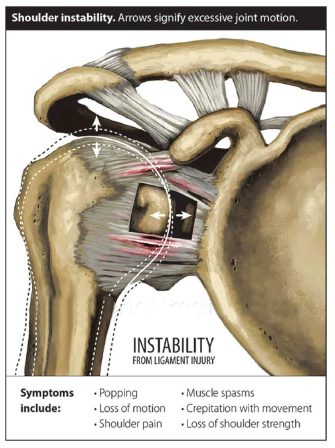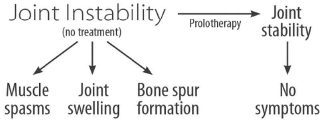Popular sports in south Florida, like tennis, golf, and swimming, require a delicate balance of shoulder mobility and stability in order to meet the demands of the sport. The way shoulder pain is addressed can mean the difference between a good game and a great game, or having to give up the game all together.
SHOULDER MOBILITY HOW MUCH IS TOO MUCH?
The shoulder joint is essentially a free-floating ball suspended in a ring of ligamentous ti ssue. It is held into the joint by the glenoid labrum and the glenohumeral ligaments. (See Figure.) The shoulder joint is the “loosest” joint of the body and is made for movement. While joint hyper mobility can be advantageous for the athlete, to have good reach and range of motion, too much laxity in the shoulder ligaments can leave it unstable. The rotator cuff muscles are the structures that move the shoulders. When the supporting ligaments around the shoulder become excessively hypermobile, the rotator cuff muscles are called upon to stabilize the shoulder, as well as move it.
Eventually these structures fatigue and the person is left with a rotator cuff tear, injury, or tendinopathy. If the training schedule is not altered and the athlete continues training the same way, this can lead to shoulder subluxations, dislocations, or glenoid labral tears.
When shoulder pain and hypermobility go from physiologic to pathologic and becomes a performance problem, what is an athlete to do?
1: Stop extra activities that increase shoulder joint laxity.
Activities that include passive stretching of the shoulder should be discontinued.
2: Allow time for ligaments to tighten after workouts.
Aggressive training exercises cause ligaments to elongate. If an athlete’s training regimen is appropriate, sufficient time will be allowed for the exercised joint structures to remodel and repair. The amount of time required for this to occur is individualized for each person. For instance, in a swimmer with shoulder
hypermobility problems, swimming training hours may need to be reduced or altered so as to allow for proper rest time between workouts that focus on the same muscle groups.
3: Add appropriate strength training.
Exercises that work all the shoulder muscles within a pain-free range, including the scapula stabilizers should be incorporated. Strength training causes muscles to tighten, which can have a protective effect for the athlete with
problematic hypermobility.
4: Assess technique.
For the athlete with a painful shoulder, certain techniques should be checked to ensure that excessive stress is not being placed on the shoulder during the swing or stroke.
5. Address contributing factors to the pain
Consider possible contributing factors outside of the primary sport. For instance, athletes can aggravate shoulder pain by sleeping on the bad shoulder. Another commonly overlooked stressor is extended computer usage. If you have shoulder pain on your dominant side, simply switch which hand you use to control the computer mouse.
If you are right-handed and have right shoulder pain, this means switching the mouse set up to the left side of the keyboard and using your left hand to operate it. This surely takes some getting used to. But it is a good test to see if, after a couple days, the shoulder improves.
 SHOULDER CLUNKING IS YOUR GAME SUFFERING BECAUSE OF IT?
SHOULDER CLUNKING IS YOUR GAME SUFFERING BECAUSE OF IT?
When the shoulder becomes unstable, it can start making a clunking or clicking noise. When the shoulder clunks or clicks with every stroke or swing motion, it can indicate a more severe, multidirectional shoulder instability. (See Figure.) Symptoms that an athlete will begin to notice can include loss of shoulder strength and motion, in addition to increased pain and muscle spasms. If this happens, the problem should be addressed at the source, not covered up with medication like ibuprofen or other NSAIDs. One of the problems with using drugs to cover up shoulder pain is that it masks the true extent of the problem, only causing more damage in the long run.

STABILIZING THE SHOULDER JOINT
The body can try to stabilize the joint in different ways: swelling, overgrowing bone (leading to arthritis}, or overuse of the surrounding muscles (leading to muscle fatigue and spasms). Because the ligaments and tendons
have a poor blood supply, they have weak healing properties. Once damaged, they often need a treatment that restarts the repair cascade.
This is why shoulder instability and pain can be successfully addressed with regenerative medicine techniques like Prolotherapy. (See Figure.) This is a natural injection therapy that stimulates joint repair-specifically of the ligament, tendon, and labral tissue-and therefore creating a more stable, strong, and pain-free shoulder for the athlete to take their sport to the next level.
PROLOTHERAPY SPECIALISTS:
Ross A. Hauser, MD.
Danielle R. Steilen. MMS, PA-C
Timothy L. Speciale, DO
(239) 303.4069 | www.CaringMedical.com
Check Also
WHAT IS MY CIRCADIAN RHYTHM AND WHY DOES IT MAKE ME FEEL SO “OFF”
By Renee Chillcott, LMHC Have you heard terms such as “biological clock” or “biorhythms”, or …
 South Florida Health and Wellness Magazine Health and Wellness Articles
South Florida Health and Wellness Magazine Health and Wellness Articles




